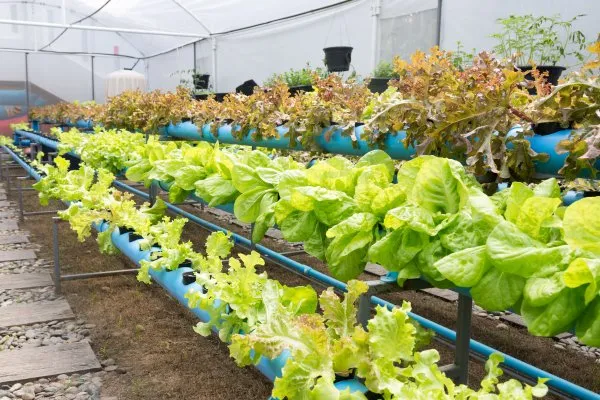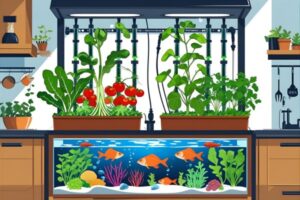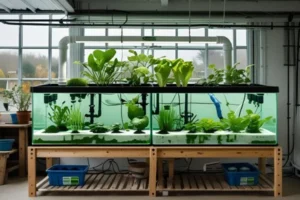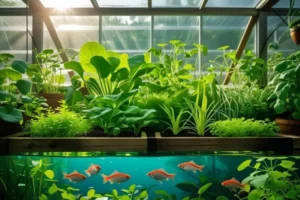How Does Aquaponics Work: Did you know that aquaponics systems use 90% less water than traditional agriculture while producing crops 2 to 4 times faster? This remarkable efficiency stems from a perfectly orchestrated biological dance between fish, plants, and beneficial bacteria that transforms waste into food through natural processes perfected over millions of years of evolution.
Many people struggle to understand how aquaponics actually works beneath the surface. They see fish swimming below and plants growing above, but the invisible biological machinery driving this sustainable ecosystem remains mysterious. Without grasping these fundamental processes, it’s impossible to design, manage, or troubleshoot aquaponics systems effectively.
This comprehensive guide reveals exactly how aquaponics works by breaking down every biological process, chemical transformation, and ecological relationship that makes these systems so remarkably productive. You’ll discover the nitrogen cycle that converts fish waste into plant food, understand the crucial role of beneficial bacteria, and learn how water chemistry creates the perfect environment for both aquatic and terrestrial life to thrive together.
By the end of this article, you’ll possess a complete scientific understanding of aquaponics mechanisms, enabling you to appreciate why these systems work so efficiently and how to harness these natural processes for your own sustainable food production. Whether you’re planning your first system or optimizing an existing setup, this knowledge forms the essential foundation for aquaponics success.
What Is Aquaponics and Why It Works
Aquaponics combines aquaculture (fish farming) and hydroponics (soilless plant cultivation) into a single, integrated ecosystem where fish waste provides nutrients for plants, while plants purify water for fish. This symbiotic relationship creates a closed-loop system that mimics natural wetland ecosystems, where similar nutrient cycles sustain diverse aquatic and terrestrial communities.
The system operates on three fundamental biological pillars working in perfect harmony. Fish serve as the nutrient source, consuming protein-rich feed and producing ammonia-laden waste through respiration and excretion. Plants act as natural biofilters, absorbing dissolved nutrients from water while releasing oxygen that benefits fish health. Beneficial bacteria function as the critical biological bridge, converting toxic fish waste into plant-available nutrients through a process called nitrification.
This elegant design delivers multiple advantages over conventional growing methods. Compared to traditional agriculture, aquaponics eliminates soil-borne diseases, reduces water consumption by 85% to 95%, and produces crops 25% to 50% faster due to optimal nutrient availability. Unlike pure hydroponics systems requiring expensive synthetic nutrients costing 50 to 100 USD per month for commercial operations, aquaponics generates nutrients naturally through fish feed conversion, reducing input costs by 60% to 80%.
The system’s efficiency stems from nutrient density and biological processing speed. Fish convert feed into bioavailable nutrients within 24 to 48 hours, while traditional composting requires 3 to 6 months for similar nutrient release. Plants receive a continuous supply of 16 essential nutrients including nitrogen, phosphorus, potassium, calcium, and trace elements, delivered in ratios optimized through millions of years of aquatic ecosystem evolution.
Environmental benefits include zero agricultural runoff, elimination of synthetic fertilizers, and carbon sequestration through increased plant biomass production. These systems can operate year-round in controlled environments, providing food security regardless of weather conditions, soil quality, or geographic limitations.
The Nitrogen Cycle: Heart of Aquaponics Systems
The nitrogen cycle forms the biological engine driving all aquaponics systems, converting toxic fish waste into essential plant nutrients through a carefully orchestrated sequence of bacterial transformations. Understanding this process is crucial for system design, management, and troubleshooting because disruption at any stage can cause crop failure or fish mortality.
Stage 1: Ammonia Production and Release
Fish continuously produce ammonia (NH₃) through two primary pathways. Gill respiration releases ammonia directly into water as fish process dissolved oxygen, while waste excretion introduces additional ammonia through urea breakdown in fish urine and feces. Protein-rich fish feeds containing 32% to 45% protein generate approximately 25 to 30 grams of ammonia per kilogram of feed consumed, with release rates varying by fish species, water temperature, and feeding frequency.
Stage 2: Nitrosomonas Bacterial Conversion
Specialized bacteria called Nitrosomonas colonize all wetted surfaces in aquaponics systems, including tank walls, plumbing, and growing media. These bacteria oxidize ammonia into nitrite (NO₂⁻) while extracting energy for cellular metabolism. This process, called ammonia oxidation, typically processes 0.1 to 0.3 milligrams of ammonia per square centimeter of bacterial surface area daily, depending on temperature, pH, and oxygen availability.
Stage 3: Nitrobacter Bacterial Processing
A second bacterial group, Nitrobacter, completes the nitrification cycle by oxidizing nitrite into nitrate (NO₃⁻). Nitrite is highly toxic to fish at concentrations above 0.5 ppm, making this conversion critical for fish health. Nitrobacter colonies typically establish 2 to 3 weeks after Nitrosomonas populations stabilize, creating the familiar “nitrite spike” observed during system cycling.
Stage 4: Plant Nutrient Uptake
Plants preferentially absorb nitrate through root systems, converting it back into amino acids and proteins for growth. Leafy greens consume 100 to 200 ppm of nitrate weekly, while fruiting plants like tomatoes require 150 to 300 ppm for optimal production. This uptake removes nitrogen from the system, preventing accumulation that could harm fish or create imbalanced plant nutrition.
The complete cycle transforms 1 gram of fish feed protein into approximately 0.4 grams of plant-available nitrogen within 3 to 5 days under optimal conditions (temperature 68°F to 78°F, pH 6.8 to 7.2, dissolved oxygen above 5 ppm).
Fish-Plant Symbiosis: Perfect Natural Partnership
The fish-plant relationship in aquaponics represents one of nature’s most efficient nutrient exchange systems, where waste from one organism becomes essential nutrition for another. This symbiosis creates a self-sustaining ecosystem that maximizes resource utilization while minimizing environmental impact through biological waste processing.
Fish Nutrient Contribution and Waste Production
Fish provide 16 essential plant nutrients through their natural biological processes. Beyond nitrogen, fish waste contains phosphorus (2% to 4% of total waste), potassium (1% to 2%), calcium (3% to 5%), and trace elements including iron, manganese, zinc, and boron. A 1-pound (454-gram) fish typically produces 0.3 to 0.5 ounces (8.5 to 14.2 grams) of waste daily, supporting 3 to 6 mature lettuce plants or 8 to 12 herb plants depending on species and growing conditions.
Feed conversion ratios directly impact nutrient availability for plants. Quality fish feeds with 1.2:1 to 1.8:1 conversion ratios ensure maximum nutrient transfer, while poor feeds with 3:1+ ratios waste resources and create water quality problems. Premium feeds containing fish meal, fish oil, and plant proteins cost 2to4 USD per pound but deliver superior nutrient profiles compared to lower-quality alternatives.
Plant Water Purification and Biological Filtration
Plants function as living biofilters, removing dissolved nutrients that would otherwise accumulate to toxic levels. Root systems create massive surface areas for nutrient absorption – a single mature lettuce plant develops 15 to 25 feet (4.6 to 7.6 meters) of root length, providing extensive biological filtration capacity. Plants also release oxygen through photosynthesis, contributing 2 to 4 ppm of dissolved oxygen during daylight hours.
Leafy greens excel at nutrient removal, processing 80% to 95% of available nitrates within 7 to 10 days. Fast-growing species like lettuce, spinach, and kale provide superior biofiltration compared to slower-growing plants like peppers or tomatoes. Strategic plant selection balances production goals with biological filtration requirements.
System Balance and Stocking Ratios
Maintaining proper fish-to-plant ratios ensures optimal system performance without nutrient deficiencies or toxicity problems. Conservative ratios start with 1 pound (454 grams) of fish supporting 5 to 8 square feet (0.46 to 0.74 square meters) of growing space, while intensive systems achieve 1 pound supporting 2 to 4 square feet (0.19 to 0.37 square meters) with additional supplementation.
Monitoring key indicators reveals system balance: fish showing normal feeding behavior and growth rates, plants displaying vibrant green coloration without deficiency symptoms, and water tests showing ammonia below 0.25 ppm, nitrites below 0.5 ppm, and nitrates between 10 to 40 ppm for optimal plant nutrition.
Beneficial Bacteria: The Invisible Workforce
Beneficial bacteria represent the most critical yet least visible component of aquaponics systems, performing the essential biological transformations that convert toxic fish waste into plant nutrition. These microscopic organisms colonize every surface in contact with system water, creating living biological filters that process nutrients 24 hours per day without interruption.
Nitrosomonas: The First-Stage Processors
Nitrosomonas bacteria specialize in ammonia oxidation, converting NH₃ into nitrite (NO₂⁻) while extracting energy for cellular growth and reproduction. These bacteria prefer alkaline environments with pH levels between 7.0 to 8.5, temperatures from 77°F to 86°F (25°C to 30°C), and high dissolved oxygen concentrations above 6 ppm for optimal performance. Each bacterial cell processes approximately 10⁻¹⁴ grams of ammonia hourly, requiring massive populations to handle typical system loads.
Colony establishment takes 2 to 4 weeks under favorable conditions, with populations doubling every 8 to 16 hours during exponential growth phases. Mature colonies reach densities of 10⁸ to 10⁹ cells per square centimeter on textured surfaces, processing 0.2 to 0.5 grams of ammonia per square meter of surface area daily.
Nitrobacter: The Final Conversion Specialists
Nitrobacter bacteria complete the nitrification process by oxidizing nitrite into nitrate (NO₃⁻), the primary nitrogen source preferred by plants. These bacteria grow more slowly than Nitrosomonas, with generation times of 12 to 24 hours compared to 8 to 16 hours for ammonia oxidizers. Nitrobacter populations typically lag behind Nitrosomonas by 1 to 2 weeks during system establishment.
Environmental preferences for Nitrobacter include pH levels from 6.5 to 7.5, temperatures between 68°F to 82°F (20°C to 28°C), and dissolved oxygen above 4 ppm. These bacteria are more sensitive to chemical disturbances, making them valuable indicators of system health and water quality stability.
Biofilm Formation and Surface Colonization
Both bacterial species form protective biofilms on system surfaces, creating three-dimensional communities embedded in self-produced polymer matrices. Biofilms provide protection from environmental stresses, concentrate nutrients for efficient processing, and enable bacterial communication through chemical signaling. Maximum biofilm development occurs on textured surfaces including lava rock, expanded clay pebbles, and plastic bio-media with surface areas exceeding 300 to 500 square meters per cubic meter.
Factors Affecting Bacterial Performance
Temperature fluctuations impact bacterial processing rates, with activity decreasing 50% for every 18°F (10°C) temperature drop below optimal ranges. Chemical treatments including chlorine, chloramine, antibiotics, and many aquarium medications can devastate bacterial populations, requiring 3 to 6 weeks for full recovery. Maintaining stable conditions and avoiding chemical disruptions ensures consistent biological filtration and system reliability.
Water and Nutrient Flow Systems
Water circulation and nutrient distribution form the circulatory system of aquaponics, ensuring continuous delivery of fish-produced nutrients to plants while maintaining optimal water quality for aquatic life. Understanding flow dynamics, system designs, and distribution methods enables optimal system performance and prevents common circulation problems.
Continuous Flow vs. Flood and Drain Systems
Continuous flow systems maintain constant water movement through growing beds, providing steady nutrient delivery and excellent oxygenation for plant roots. These systems typically use submersible pumps ranging from 200 to 800 gallons per hour (757 to 3,028 liters per hour) depending on system size, with total system turnover occurring every 1 to 3 hours. Energy consumption ranges from 15 to 45 watts for residential systems, costing 2to8 USD monthly in electricity.
Flood and drain systems alternate between filling grow beds and allowing them to drain completely, creating wet-dry cycles that provide both nutrient delivery and root oxygenation. Timer-controlled systems typically flood beds for 15 to 30 minutes every 1 to 4 hours, depending on plant size, weather conditions, and growing media type. These systems use smaller pumps (100 to 400 gallons per hour) but require reliable timing mechanisms costing 25to75 USD.
NFT (Nutrient Film Technique) Flow Dynamics
NFT systems create thin water films flowing continuously through sloped channels, providing constant nutrient contact with plant roots while maintaining excellent oxygenation. Optimal flow rates range from 0.5 to 1.5 liters per minute per growing channel, with channel slopes between 1:30 to 1:50 (2% to 3% grade) ensuring proper drainage without stagnation.
Channel design affects nutrient distribution uniformity, with rectangular channels 2 to 4 inches (5.1 to 10.2 cm) wide providing optimal root contact and cleaning access. Round pipes often create dead zones where roots don’t contact flowing nutrients, reducing growth rates by 15% to 25% compared to properly designed rectangular channels.
Deep Water Culture (DWC) Circulation
DWC systems suspend plant roots directly in oxygenated nutrient solution, requiring robust aeration to prevent root rot and maintain dissolved oxygen above 5 ppm. Air pumps delivering 0.5 to 1.0 watts per gallon of water volume ensure adequate oxygenation, while air stones create fine bubbles for maximum oxygen transfer efficiency.
Water circulation in DWC systems focuses on gentle movement to prevent root damage while ensuring nutrient mixing and temperature uniformity. Circulation pumps sized at 3 to 5 times tank volume per hour provide adequate mixing without creating excessive turbulence that could stress fish or damage delicate root structures.
Media Bed Flow Patterns
Media bed systems rely on growing media to distribute water and nutrients throughout the root zone while providing biological filtration surfaces for beneficial bacteria. Flow patterns depend on media choice: expanded clay pebbles allow rapid drainage and excellent oxygenation, while smaller aggregate materials provide more surface area for bacterial colonization but require careful flow rate management to prevent waterlogging.
Proper media bed design includes drainage systems preventing water stagnation, inlet distribution preventing channeling, and overflow protection maintaining consistent water levels. Well-designed media beds process 2 to 5 gallons (7.6 to 18.9 liters) per cubic foot of media per hour while maintaining optimal moisture and oxygenation for both plants and beneficial bacteria.
pH and Water Chemistry Balance
Water chemistry in aquaponics systems requires careful balance to support fish health, bacterial activity, and plant nutrition simultaneously. The interdependent relationships between pH, nutrient availability, and biological processes create a dynamic system where small changes can significantly impact overall performance and productivity.
Optimal pH Ranges and Biological Impacts
Aquaponics systems function best within pH ranges of 6.8 to 7.2, representing a compromise between competing biological requirements. Fish prefer slightly alkaline conditions (7.0 to 8.0), while plants grow optimally in neutral to slightly acidic conditions (6.0 to 7.0). Beneficial bacteria perform most efficiently at pH 7.5 to 8.5, making system pH management a constant balancing act.
pH levels outside optimal ranges dramatically impact nutrient availability through chemical reactions that bind essential elements into unavailable forms. Iron deficiency appears rapidly when pH exceeds 7.5, as iron precipitates into insoluble compounds unavailable to plant roots. Phosphorus availability decreases by 50% when pH drops below 6.0 or rises above 8.0, limiting plant growth despite adequate fish waste production.
Natural pH Buffering and System Stability
Mature aquaponics systems develop natural pH buffering capacity through biological processes and mineral accumulation. Fish respiration and bacterial nitrification continuously produce acids that lower system pH over time, while calcium carbonate from fish waste and hard water sources provides alkaline buffering. This natural system typically maintains pH within 0.2 to 0.4 units without intervention.
Growing media contributes significantly to pH stability, with limestone-based aggregates providing alkaline buffering while organic materials like coconut coir create acidic conditions. Expanded clay pebbles offer neutral pH characteristics, making them ideal for systems requiring precise pH control. Media selection should consider both physical growing properties and chemical buffering effects.
Monitoring and Adjustment Strategies
Daily pH monitoring using digital meters (15 to 45 USD) or test strips (8 to 15 USD for 100 tests) enables early detection of pH drift before biological impacts occur. Digital meters provide accuracy within ±0.1 pH units but require weekly calibration using standard buffer solutions (pH 4.0, 7.0, and 10.0) costing 10to20 USD for calibration kit.
pH adjustment requires gradual changes to prevent shock to fish and bacteria. Potassium hydroxide (raising pH) or phosphoric acid (lowering pH) work effectively in small doses, with changes limited to 0.2 pH units per day maximum. Sudden pH changes exceeding 0.5 units can cause fish stress, bacterial die-offs, and plant nutrient lockout requiring weeks for system recovery.
Alkalinity and Carbonate Hardness
Alkalinity measures the water’s capacity to resist pH changes, with optimal levels between 50 to 150 ppm for aquaponics systems. Low alkalinity creates unstable pH conditions with rapid fluctuations, while excessive alkalinity makes pH adjustment difficult and expensive. Regular alkalinity testing using titration kits (20to35 USD) helps predict pH stability and adjustment requirements.
Carbonate hardness directly relates to alkalinity, with levels between 3 to 8 dKH (degrees of carbonate hardness) providing optimal buffering without excessive mineral buildup. Systems with low carbonate hardness require alkalinity supplementation using potassium bicarbonate (12 to 18 USD per pound) or calcium carbonate (8 to 15 USD per pound) to maintain stable water chemistry.
System Cycling and Establishment Process
System cycling represents the critical establishment phase where beneficial bacterial colonies develop sufficient populations to process fish waste safely and efficiently. Understanding this biological maturation process enables successful system startup while avoiding common mistakes that lead to fish mortality or prolonged establishment periods.
Pre-Cycling Preparation and Setup
Successful cycling begins with proper system preparation including thorough cleaning of all components, installation of circulation and aeration equipment, and addition of dechlorinated water. Municipal water containing chlorine or chloramine requires treatment with sodium thiosulfate (8 to 12 USD per pound) at 1 gram per 10 gallons (37.8 liters) to neutralize chemical disinfectants harmful to beneficial bacteria.
Initial bacterial inoculation accelerates establishment using commercial bacterial supplements containing Nitrosomonas and Nitrobacter cultures. Quality products like ATM Colony (15 to 25 USD per bottle) or Microbe-Lift NiteOutII (18 to 30 USD) provide live bacterial cultures that begin processing ammonia within 24 to 48 hours under optimal conditions.
Fishless Cycling Protocol
Fishless cycling protects fish from toxic ammonia exposure while establishing bacterial populations using artificial ammonia sources. Pure household ammonia (without additives) or ammonium chloride provides controlled ammonia dosing at 2 to 4 ppm daily until bacterial colonies develop sufficient processing capacity.
The cycling timeline typically spans 4 to 8 weeks with distinct phases: Week 1-2 shows ammonia accumulation as bacterial populations establish, Week 3-4 demonstrates ammonia decline with nitrite spike appearance, and Week 5-6 exhibits nitrite decline as Nitrobacter populations mature. Complete cycling occurs when 4 ppm ammonia additions process to zero within 24 hours without nitrite accumulation.
Fish-In Cycling Considerations
Fish-in cycling requires extreme caution due to ammonia toxicity risks, but enables faster bacterial establishment through continuous waste production. Hardy fish species like goldfish or koi tolerate cycling conditions better than sensitive species like trout or bass. Initial stocking should not exceed 25% of planned capacity to minimize waste production during bacterial establishment.
Daily water testing becomes critical during fish-in cycling, with ammonia levels above 0.5 ppm requiring immediate intervention through partial water changes or bacterial supplements. Emergency ammonia detoxifiers like Prime (12 to 18 USD) temporarily neutralize ammonia without disrupting biological cycling processes.
Monitoring Parameters and Progression Indicators
Successful cycling requires consistent monitoring of ammonia, nitrite, nitrate, pH, and dissolved oxygen levels using quality test kits (35 to 65 USD for master test kit). Digital parameter meters (45 to 125 USD) provide convenient daily monitoring with improved accuracy over colorimetric test strips.
System maturity indicators include: ammonia processing from 4 ppm to zero within 24 hours, nitrite levels remaining below 0.25 ppm during ammonia additions, nitrate accumulation between 20 to 80 ppm, and stable pH without rapid fluctuations. Visual indicators include biofilm development on surfaces, clear water conditions, and absence of foam or unusual odors.
Plant Introduction and System Balance
Plant introduction should occur gradually after bacterial establishment to prevent overwhelming immature biological filtration. Start with fast-growing, hardy species like lettuce or herbs that provide immediate nutrient uptake without stressing developing bacterial populations. Full planting capacity typically occurs 2 to 4 weeks after complete cycling.
System balance requires ongoing monitoring and adjustment as bacterial populations, fish biomass, and plant capacity mature together. Mature systems typically achieve stability 3 to 6 months after initial startup, with natural buffering capacity and established biological rhythms requiring minimal intervention for continued operation.
Conclusion
Understanding how aquaponics works reveals the elegant simplicity behind this revolutionary growing method that transforms waste into food through natural biological processes. The nitrogen cycle serves as the system’s biological engine, converting fish waste into plant nutrition through specialized bacterial communities that colonize every wetted surface. This remarkable process produces crops 25% to 50% faster than traditional agriculture while using 90% less water through perfect nutrient recycling.
The fish-plant symbiosis creates a self-sustaining ecosystem where each organism supports the others: fish provide 16 essential nutrients including nitrogen, phosphorus, and trace elements, while plants purify water and create optimal conditions for aquatic life. Beneficial bacteria form the invisible workforce, processing 0.2 to 0.5 grams of ammonia per square meter daily while maintaining water quality within safe parameters for both fish and plants.
Successful aquaponics systems balance water chemistry, circulation, and biological processes to create stable, productive environments that can operate year-round. System cycling typically requires 4 to 8 weeks for bacterial establishment, after which mature systems provide decades of reliable food production with minimal external inputs beyond fish feed and electricity.
The science behind aquaponics demonstrates nature’s efficiency in nutrient cycling and waste processing, offering solutions for sustainable food production that address global challenges including water scarcity, soil degradation, and food security. These systems work because they harness millions of years of evolutionary adaptation, creating partnerships between species that maximize resource utilization while minimizing environmental impact.
Ready to harness the science of aquaponics for your own sustainable food production? Start with a small system to experience these natural processes firsthand, and discover why aquaponics represents the future of efficient, environmentally responsible agriculture!
Frequently Asked Questions (FAQ)
How long does it take for the nitrogen cycle to fully establish in aquaponics?
The complete nitrogen cycle establishment typically takes 4 to 8 weeks under optimal conditions (temperature 68°F to 78°F, pH 6.8 to 7.2, dissolved oxygen above 5 ppm). Nitrosomonas bacteria establish first within 2 to 3 weeks, followed by Nitrobacter populations after another 1 to 2 weeks. System maturity indicators include processing 4 ppm ammonia to zero within 24 hours and maintaining nitrite levels below 0.25 ppm during ammonia additions.
Why do my plants show yellowing leaves even though my fish are healthy?
Plant yellowing typically indicates nutrient deficiencies despite healthy fish populations. Iron deficiency causes yellowing between leaf veins when pH exceeds 7.5, making iron unavailable despite adequate levels. Potassium deficiency shows as brown leaf edges when fish populations are insufficient relative to plant biomass. Nitrogen deficiency appears as overall yellowing when beneficial bacteria populations haven’t fully established or when growing space exceeds fish waste production capacity.
What happens if beneficial bacteria die off in my system?
Bacterial die-offs create dangerous ammonia spikes that can kill fish within 24 to 48 hours. Common causes include chlorine exposure, antibiotic treatments, pH shock, or oxygen depletion. Emergency response includes immediate partial water changes (25% to 50%), addition of beneficial bacteria supplements, and ammonia detoxifiers to prevent fish mortality. Complete bacterial recovery typically requires 3 to 6 weeks, during which careful monitoring and fish load reduction are essential.
How much fish waste is needed to support plant growth?
Fish waste production varies by species, size, and feeding rate, but general ratios provide guidance. One pound (454 grams) of fish typically produces enough nutrients to support 5 to 8 square feet (0.46 to 0.74 square meters) of leafy greens or 3 to 5 square feet (0.28 to 0.46 square meters) of fruiting plants. Daily waste production averages 0.3 to 0.5 ounces (8.5 to 14.2 grams) per pound of fish, generating sufficient nitrogen for 3 to 6 mature lettuce plants.
Can aquaponics work without electricity for pumps and aeration?
Optimal water temperatures range from 68°F to 78°F (20°C to 25.6°C) for most aquaponics combinations. This range supports efficient bacterial activity, adequate dissolved oxygen levels (6 to 8 ppm), and comfortable conditions for both temperate fish species and common vegetables. Temperatures below 60°F (15.6°C) slow bacterial processing by 50% or more, while temperatures above 85°F (29.4°C) reduce dissolved oxygen and stress both fish and plants.



